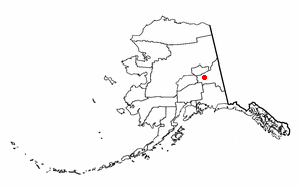Big Delta, Alaska
|
|
Big Delta is a census-designated place located in Southeast Fairbanks Census Area, Alaska. As of the 2000 census, the population of the CDP is 749. Big Delta is at the confluence of the Delta River and the Tanana River and gets it name from the huge river delta formed by the confluence.
| Contents |
Geography
Big Delta is located at 64°8'50" North, 145°48'6" West (64.147324, -145.801545)Template:GR.
According to the United States Census Bureau, the CDP has a total area of 158.3 km² (61.1 mi²). 143.0 km² (55.2 mi²) of it is land and 15.4 km² (5.9 mi²) of it is water. The total area is 9.70% water.
Demographics
As of the censusTemplate:GR of 2000, there are 749 people, 165 households, and 117 families residing in the CDP. The population density is 5.2/km² (13.6/mi²). There are 232 housing units at an average density of 1.6/km² (4.2/mi²). The racial makeup of the CDP is 95.46% White, 0.13% Black or African American, 1.47% Native American, 0.53% Asian, 0.00% Pacific Islander, 0.00% from other races, and 2.40% from two or more races. 2.54% of the population are Hispanic or Latino of any race.
There are 165 households out of which 39.4% have children under the age of 18 living with them, 61.2% are married couples living together, 6.7% have a female householder with no husband present, and 28.5% are non-families. 21.8% of all households are made up of individuals and 7.3% have someone living alone who is 65 years of age or older. The average household size is 3.18 and the average family size is 3.90.
In the CDP the population is spread out with 36.3% under the age of 18, 10.1% from 18 to 24, 23.5% from 25 to 44, 24.0% from 45 to 64, and 6.0% who are 65 years of age or older. The median age is 29 years. For every 100 females there are 92.5 males. For every 100 females age 18 and over, there are 96.3 males.
The median income for a household in the CDP is $49,000, and the median income for a family is $53,125. Males have a median income of $32,250 versus $37,708 for females. The per capita income for the CDP is $14,803. 30.0% of the population and 7.9% of families are below the poverty line. Out of the total population, 18.9% of those under the age of 18 and 16.0% of those 65 and older are living below the poverty line.
History
From at least 10,0000 years ago to the present, Athabascan Indians have inhabited portions of the interior of Alaska. They survived by hunting the abundant game and fishing in the rivers of the interor of Alaska.
Beginning in 1899, the United States Army built a pack trail from Valdez, on the south coast of Alaska, to Eagle, northeast of Big Delta, a distance of about 660 km (409 miles). The trail crossed the Tanana River near the confluence of the Delta and Tanana Rivers.
Gold was discovered in 1902 in Fairbanks, about 150 km (90 miles) north of the crossing of the Tanana River. Roadhouses were built along the pack trail that connected the south coast of Alaska with Fairbanks. One such roadhouse was Bates Landing, which was built at the confluence of the Delta and Tanana Rivers, about 12 km (8 miles) north of the current Delta Junction, in the area known now as Big Delta. The U. S. government collected a toll on the south side of the Tanana River from all passengers crossing north. In 1904 work began on the Richardson Highway, which mostly followed the route of the pack trail.
In 1906, John Hajdukovich bought the roadhouse and enlarged it. In addition to running the lodge there, he took hunting parties into the nearby Granite Mountains and traded with the Athabaskans in the surrounding area. An 18-year-old Swedish girl named Rika Wallen came to the roadhouse to work for John. After several years, John deeded the roadhouse to Rika in lieu of back wages he owed her. Rika also homesteaded an adjoining piece of land. Rika's Roadhouse and the adjacent property are now the Big Delta State Historical Park.
In 1928 a herd of bison were brought from the U. S. state of Montana to Big Delta, because they were thought to be threatened with extinction in the continental United States. The herd still roams in the Delta Junction area, about 12 km (8 miles) south of Big Delta.
The construction of the Alaska Highway during World War II shifted much of the economic activity of the area south to Delta Junction. Later history of the area can be found in the entry for Delta Junction.

